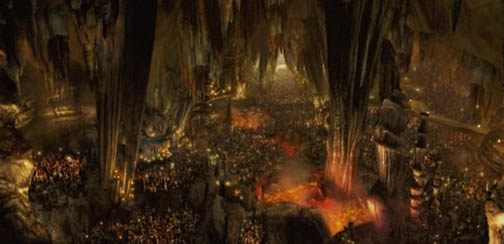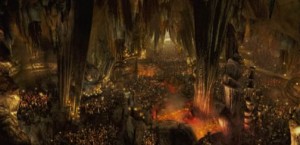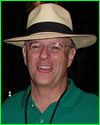
 Archival interview with Captain J. Michael Edwards from the official Matrix website.
Archival interview with Captain J. Michael Edwards from the official Matrix website.
THE ZION TEMPLE
MATRIX: Which set are we on right now?
CAPT. EDWARDS: We’re on what’s known as the Zion Temple set. It’s built in a former aircraft hangar at a former naval air station in Alameda. This building has been used for several productions, but never anything of this kind we have here. This production company came and met with the Alameda Fire Department early on, because of the special nature of the project they’re putting on here, and the number of people they’re working with, so we’ve been able to work out all the safety precautions with them from day one.
It has been a learning experience for me; I haven’t done a lot of movie productions, especially this kind. Everyone has been able to work with me: we’ve done burn tests, we’ve developed special control devices for the torches they’re using, and so far everything has been working out really well.
Initially, this was going to be a set with x number of people, and now it’s gotten to be even more people, they’re also going to add candles, and they’ve added torches. As a fire guy, I’m nervous when torches, fires, this many people, and this much foam, are put together, but we’ve been able to work out quite a few precautions. We’re going to have standby fire crews, we’re setting up fire hoses throughout, we have evacuation plans, and the construction people have reworked hardware on all the doors. All in all I’m looking forward to it.
MATRIX: What are some of the special precautions taken for this set?
CAPT. EDWARDS: We were concerned about what would happen if someone dropped a torch onto the styrofoam set. When they first started off, I had no idea what they were going to do for torches, but they came up with several ideas. Ultimately they came up with a propane torch, which has a pressure switch on it, so if you let go of the torch, or if you drop it, the gas shuts off immediately, and the flame goes out immediately
We tested the styrofoam for how long would it take to catch on fire: it has different kinds of paint, plaster and foams sprayed on top of it to give it texture, so we were worried about how those would catch on fire. We found that with the dirt on the ground and the torches having a dead man switch on them, a flame goes out right away. We’ve talked to the production about where they’re putting the torches, and how close they are to vertical pieces and walls around here, so where we’re putting them has been another precaution.
For the candles special wicks were worked out, and lots of burn tests were done on the candles to see how long they burned. Store candles looked terrific, but they had to make candles with special wicks so they’d look like a candle on film. We didn’t want to get smoke all over the place, and we wanted candles the camera would like, but not something that would get so hot it could cause things to ignite.
This is a sprinkled building, but water from the sprinkler system could cause a lot of damage, like wash away the dirt, and knock things down. In here we have lots of lights and warm temperatures from the lights, so we’ve done tests on the lighting. About two weeks ago we had an unusually hot spell in the Bay area – there were record temperatures – so we had the good fortune to be able to test all the lighting in a worst-case scenario. It was hot outside, it was hot inside, and we were able to make sure, at that point, that we weren’t getting close to the temperature to set off the sprinklers.
MATRIX: Were there any tests done on foam where it actually ignited?
CAPT. EDWARDS: None of the foam ever ignited; we never even got it to melt. We took burning blow torches designed to burn paint off of buildings, which we thought would be far worse than exposure to the regular handheld torches, and held that on the foam in horizontal and vertical planes to see if we could get it to light. We were never really successful, we never got it to burn or melt… even off gas. I imagine if we got a welding torch and put hours of work into it we could have got it to ignite, but only for severe temperatures above what we’re going to be doing here.
 MATRIX: Did the electric cabling above and beneath the set create a fire safety issue?
MATRIX: Did the electric cabling above and beneath the set create a fire safety issue?
CAPT. EDWARDS: Not particularly, especially above. This building was refit before this production started, so the sprinkler system, the valves, the piping grids, and everything, were modified to meet current California Building Code requirements for studios. Essentially, this is a modern studio; all the safety precautions recognized by the State Fire Marshal’s Office are in this building.
If you look at the electrical and control devices the movie industry uses, there are no lightweight extension cords, and no frizzy connections; everything is very heavy duty, probably rated way beyond any of the loads they use. Exceptional electric loads are required here, and they have generators offsite to do it, so they’re able to control their own power grid, essentially; also to de-energize. All the lights and control devices are on individual dimmers, and they have infrared temperature recording devices on the set, so we’re able to periodically shoot with a laser beam and see what the temperatures are. If we get too high we can wait a little while between a scene, cool the lights down, or dim them between each shot.
This set is a complex maze underneath; it’s essentially carved out of styrofoam blocks all glued together, but there are routes to go around, and there are people who will be checking control devices. There’s air conditioning underneath the lava pits – where we expect some elevated temperatures because of the lighting under there – but there are ways to get under there to record that and check it. They’re even running air conditioning to the lava, so we have got cool hot lava.
MATRIX: Was it necessary to test the lava for fire safety?
CAPT. EDWARDS: I have, although essentially it’s a milkshake thickening ingredient made from vegetable products, we did early tests in test tanks and confirmed it’s about as flammable as a milkshake is. It’s a super cherry strawberry milkshake over there – I haven’t seen it gurgle yet, although I’ve seen it lit.
MATRIX: How will the 940 people who will populate the Zion temple set next week learn the evacuation procedures?
CAPT. EDWARDS: We are going to have a pre-brief with all the extras when they get here, in case of an emergency. The way the exits work for this building, and the way they are for the safety codes, meet way more of the exit requirements than any commercial building would meet, by a factor of about three or four hundred per cent.
We’re also going to have standby fire crews on scene during the time when most extras are on set, so they’ll be able to assist people out of here if necessary. Our primary setup for all the fire hoses we’ve set up is for control and preservation of the exits. We’ll make a quick attack on a fire – if that does occur and it’s small enough – the best way is to put it out right there. If for some reason something gets ahead, then we’ll fall back, protect the exit, and get the people out of here.
The Special Effects guys are building special latches for the doors, so they can be controlled from the inside and outside. They’ve rebuilt the doors so they work really smoothly – the doors they’re going to use are called ‘elephant doors’, and they’re big enough to get elephants through, so we’ll be able to get a lot of people out of here quickly.
MATRIX: How long have you been on this production so far?
CAPT. EDWARDS: I think they were first up here in January 2001, so I met with them almost a year ago when they were talking about coming in here [approx. August 2000]. We talked about some of their pyrotechnic ideas – there have been lots of damaged and blown up cars on this show.
I was able to gear up by taking some training courses from the State Fire Marshal’s Office for what we were looking at for pyrotechnics. I have a history with buildings and typical tenants, with fabricators and manufacturers, so we’re not used to thinking about blowing up cars and bullet holes and launching things. With the training, when people said, “We want to blow up this,” instead of saying, “Geez, I don’t think so,” we could say, “That sounds kind of cool, let’s talk about how we can do it so no one gets hurt.”
THE FREEWAY
MATRIX: What kind of precautions can you take with fifteen cars doing pile ups, such as in the freeway sequence?
CAPT. EDWARDS: It was very different on the freeway. When you’re inside a building, you’re constrained, so if something goes wrong you’re going to get a smoke build up and there are limited ways to get out. This building has about eleven exits to get out… but you’re still inside a building. On the Freeway set, you’re out in the complete open air. That’s a mile and three quarters of freeway in the middle of nowhere, except for an abandoned airport around it. So there’s not any real danger of something outside catching the freeway on fire, and there’s no real danger of it catching something else on fire. In the freeway, if there’s a problem, there are a really limited amount of combustibles, there are just the vertical walls.
The difficulty with the freeway was access to get in and out, but that’s no different to any other freeway. Actually, it was way better than any other freeway, because you could take a chainsaw and cut a hole in the sound walls if you had to get in – it’s kind of tough to do that on concrete. We were furnished in advance with schedules of what they were going to do, and we were also furnished with maps and layout routes of the whole freeway. There were lots of on ramps and off ramps on this freeway that were actually useable, there were overpasses, there were standby medical people, and standby ambulances. We had a standby fire engine for a few of the scenes that presented a little bit more hazard. None of it was ever needed; it was very well controlled. That’s the big difference: outdoors you have a lot more latitude, if you’re not going to catch all the adjacent properties on fire.
THE PARK SET
MATRIX: Did the Park set present any difficult fire safety issues?
CAPT. EDWARDS: There have been almost no pyrotechnics going on in that set – there were no open flames, and no large accumulations of people. For that building, they built new exit corridors out of it from the back, so it’s served by at least four exits now; there used to only be two. Also, it’s pretty wide open in there, there are limited people, and they’re professionals on the set. The Temple set presents a problem only when we get the sheer numbers of extras in here; that’s what makes this one so special. The only nerve-racking thing about the Park set is getting out of there without getting mugged – I mean, you don’t know quite know where you are when you’re in there… if you let your imagination go.
MATRIX: It must be difficult to look at fire safety from such a different angle.
CAPT. EDWARDS: Yes, it’s different from any kind of business – normally we’re not looking at creating fire inside. On this production especially, and virtually all the other productions we’ve had, there’s such a safety consciousness, it’s not like pulling teeth to get things to be safe. When I suggest something I’d like done, it’s nothing new for them, they’ve heard it a lot. I have friends I’ve met through other classes down in Burbank Fire Department who have lots of experience, so I’m able to rely on them, and I do rely on the people with the film.
The Pyrotechnician [Larry Roberts] on the US portion of this film, has a claim to fame different to most industries. Typically, you would look at things and regulate it one way, because it’s going to be there for a long time. Sets here have taken months and months to build, they’re filmed in a couple of weeks, and they’re out of here within a couple of weeks. There’s nothing permanent about this industry; there’s a transient nature to the whole thing. This is the ultimate collection of creative people; even the graffiti underneath is a good laugh – they’ve had fun with nicknames on separating the Red Sea for Moses. Larry has been really up front with me, we’ve arranged for test explosions on everything.
We’re looking forward to a lot more movies coming up here too. I’m hoping this shows that we have the talent in the Bay area to put on this kind of production and make it.
MATRIX: Thanks Michael.
Interview by REDPILL
June 2001

Be the first to comment